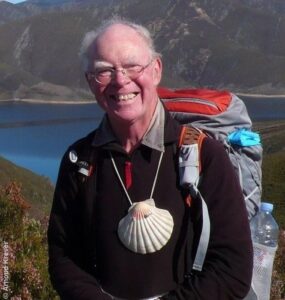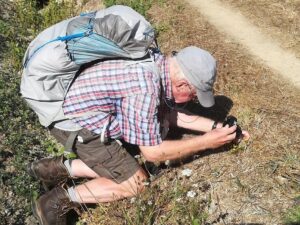Flores de los Caminos a Santiago is a website that has been build with the purpose to make it easier for pilgrims to Santiago de Compostela to determine the names of the flowers they have photographed on the Way. To stimulate the interest in the flora of Spain and Portugal in general is a purpose as well.
The start of this project has been unintentional. I walked in 2004/2005 – 2007 from my home in Den Haag (La Haya/The Hague) in the Netherlands to Santiago and back home again in commemoration of my wife Willie Malkus who had died of breast cancer (on the 25th of july 1999, the name day of St. James in a Holy Year).
Back home again I found myself hooked by the Camino. In Spain and Portugal more than twenty different Caminos are waymarked by the familiar yellow arrows. They have starting points all over Iberia and all have their end either in Santiago or on some point of another Camino, for example the well known Camino Francés.
To date I have arrived in Santiago 33 times which corresponds to some 21 different Caminos. A number of different small Caminos, the last 100+ kilometre stretches to Santiago, I have walked more than once. On the Way I made photos of flowers, at first merely to make more variety in the series of photos of a Camino. For me to have nice pictures was not enough. As a biologist I wanted to know the names of these plants. Gradually the collection of photos of plants grew. At some point I realised that the collection might be quite unique and I started to collect photos of plants in earnest. Now the collection contains more than 1100 species. All the photos have been made along a Camino. This website is the way to share this collection with the world.
This website should beconsidered as a contribution of a person who is, although a biologist, not an expert in botanics. In an undertaking of this magnitude it is almost inevitable that a number of mistakes have been made. Often the identity of a photographed plant was clear. Where I had my doubts it is pointed out in the information. It must be pointed out that this website is not a scientific undertaking and I am the sole person responsible for the identification of the photographed species. No institute has taken part of the work.
To photograph plants as a walking pilgrim poses some difficulties. First of all each day I have to reach my destination in time. To be able to walk twenty to twentyfive kilometers per day to the next albergue is a must. So time is in short supply. Walking at an average speed of 4 kms/hour means that small or inconspicious flowers are easily overlooked. Furthermore walking a camino can best be done in april, may and the first half of june. As a consequence plants that flower before of after this period are underrepresented.
The classification of the species of plants follows that of the website Anthos for practical purposes.
The inventarisation of the flora of Spain is far from complete. Many botanists tend to work in “promising areas”. The camino’s of course have no preference for botanically promising areas. As a result unexpected findings may occur. Both common and rare species are included in this collection. This website is not a flora.The popular names in six European languages are given as well as information about the time of flowering, color and size of the flowers, the size of the plants, the distribution and abundance and some ecological information. Identification of a species has to be done mainly by comparing photographs.
All the Caminos I have walked as a substitute for another person. “Vicarie pro…”, “As a substitute for…”. For a short article about this subject click here. Vicarie Pro
On my caminos I have seen in villages, towns, churches and cathedrals or along the way lots of images and symbols related to Saint James or to pilgrims. I collected these as well. I found it always very rewarding to find another fine specimen. They too are presented in this website.
You as a visitor to this webside are free to download pictures of this website as long as you don’t use them to earn money. There is no protection against downloading.
I owe a lot of gratitute to a great lot of people, to hundreds of Spanish men and women on the Camino, to Harry Hofstede and Ad van der Helm, successive parish priests of the Church of St. James in The Hague, to Luis Tejero González, Virginia González Martínez and Patricia Grosfeld of the Spanish embassy in The Hague, to Simone Spuij-Fraaij, to Yula van Barneveld, Kees Fokkens and Harry Couzijn, to Han Lasance and Fons Boink (Nederlands Genootschap van Sint Jacob) and to my present wife, Annet Cames van Batenburg, for all her encouragement and leaving me at work without complaints.
For further information, suggestions, contributions or to report mistakes use a.p.krever@gmail.com.
I wish you a lot of enjoyment “and a good way”!
Arnoud Krever
About Arnoud Krever
Arnoud Krever (1948), studied biology at the universities of Leiden and Amsterdam and pysics at the Hogeschool Holland in Diemen, was a teacher of biology, physics and sciences at the Mondriaan College for Second Chance Education (VAVO) in The Hague. Now retired.


List of Caminos
- 2004 – 2005 Den Haag – Santiago; 2005 – 2007 Santiago – Den Haag;
- 2009 Vía de la Plata + Camino Sanabrés, Sevilla – Salamanca – Ourense – Santiago;
- 2009 Camino Francés, Sarría – Santiago;
- 2010 Camino Mozarábe, Granada – Merida + Camino Sanabrés, Ourense – Santiago;
- 2010 Camino Primitivo, Oviedo – Melide + Camino Francés, Melide – Santiago;
- 2010 Camino Portugués, Porto – Ponte de Lima + 2011 Ponte de Lima – Santiago;
- 2011 Camino de Levante, Valencia – Zamora + Camino Sanabrés, Ourense – Santiago;
- 2012 Camino del Norte, Hendaye (F) – Santiago;
- 2012 Camino Francés, Astorga – Santiago;
- 2013 Toulouse (F) – Santiago, Toulouse – Col de Somport + Camino Aragonés, Col de Somport – Puente de la Reina + Camino Francés, Puente de la Reina – Santiago;
- 2013 Camino Inglés, Ferrol – Santiago;
- 2014 Camino de Madrid, Madrid – Sahagún + Camino Francés, Sahagún – Santiago;
- 2015 Camino Sanabrés, Ourense – Santiago;
- 2015 Camino Inglés, Ferrol – Santiago;
- 2015 Camino Sanabrés, A Gudiña – Santiago;
- 2015 Ruta de la Lana, Alicante – Burgos + Camino Portugués, Valença do Minho – Santiago;
- 2016 Camino de San Jaume, Barcelona – Santa Cilia de Jaca + Camino Aragonés, Santa Cilia de Jaca – Puente de la Reina + Camino Sanabrés, Ourense – Santiago;
- 2016 Camino Primitivo, Lugo – Melide + Camino Francés, Melide – Santiago;
- 2016 Camino Primitivo, Lugo – Melide + Camino Francés, Melide – Santiago;
- 2016 Camino Vasco del Interior, Irún – Santo Domingo de la Calzada + Camino de Invierno, Ponferrada – A Laxe + Camino Sanabrés, A Laxe – Santiago;
- 2016 Camino Primitivo, Lugo – Melide + Camino Francés, Melide – Santiago;
- 2017 Camino del Ebro, Riumar – Logroño + Camino Sanabrés, Ourense – Santiago;
- 2017 Camino Primitivo, Lugo – Melide + Camino Francés, Melide – Santiago;
- 2017 Camino del Norte, Ribadeo – Arzúa + Camino Francés, Arzúa – Santiago;
- 2018 Camino Catalán, Monasterio de Sant Pere de Rodes – Montserrat – Fraga + 2019 Camino Catalán, Fraga – Fuentes de Ebro + Camino Castillano-Aragonés, Gallur – Santo Domingo de Silas + Camino Primitivo, Lugo – Melide + Camino Francés, Melide – Santiago;
- 2019 Camino Portugués, Tui – Santiago;
- 2019 Camino Sanabrés, A Gudiña – Santiago;
- 2021 Ruta del Argar, Lorca – Toledo + Camino Sanabrés, Ourense – Santiago;
- 2021 Camino Sanabrés, Ourense – Santiago;
- 2022 Camino Olvidado, Bibao – Ponferrada + Camino Sanabrés, Ourense – Santiago;
- 2022 Camino de Sagunto, Sagunto – Soria + Camino Sanabrés, Ourense – Santiago;
- 2023 Camino de la Plata Portugués, Zamora – Santiago;
- 2023 Camino Sanabrés, Ourense – Santiago.
More interesting links
http://www.anthos.es/ Anthos is a webside of the Real Jardín Botánico in Madrid, a botanical institute with authority. The scientific names of the species of plants in my webside are, almost without exception, conform Anthos. Anthos gives distribution maps of all the Spanish plant species. Photographs of most of the species as well. The popular names can be found. All the known species in a given region can be found as well as all the species of a plant family in a given province. The webside is highly recommended.
http://www.floraiberica.es/ The official scientific flora of Iberica, Spain and Portugal. Very useful, more so if you have command of the Spanish language.
http://www.florasilvestre.es/mediterranea/index.htm Flora silvestre del Mediterraneo y Macaronesia. A most useful webside by the botanist José Quiles. Excellent photographs!
https://flora-on.pt/ Flora-on, Flora of Portugal. A very useful flora. The photographs are very good.
https://www.actaplantarum.org/ Flora or Galery of (most of) the plant species of Italy.
The quickest way to get pictures of a certain plant species is to write the scientific plant name in Google Pictures. The scientific name of a plant may have changed in the course of time so it is often useful to search using synonims as well.